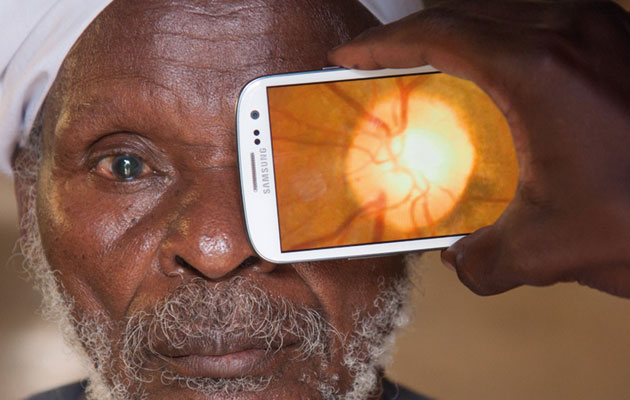|
|
||
|
Until now, doctors have been losing the battle against preventable blindness in the world’s most remote regions. By putting diagnosis in the hands of the community, the Peek smartphone system is set to be a major breakthrough “The problem isn’t the ability to provide treatment but the huge distances between the people who can provide it and those who need it,” Andrew Bastawrous says. “We are there to link the two.” The ophthalmologist was running a research project in rural Kenya when he encountered the logistical nightmare of transporting bulky, fragile medical equipment, and people to operate it, to remote locations with bad roads and no power. Two striking statistics – first, that 80 per cent of blindness in low-income countries is preventable; second, that more people in Sub-Saharan Africa have access to a mobile phone than to clean running water – provided the basis for a solution: a smartphone-based diagnostic system that a person with basic training can use wherever it is needed. Developed by a multi-disciplinary team of doctors and engineers from the London School of Hygiene & Tropical Medicine, the University of Strathclyde and the Glasgow Centre for Ophthalmic Research, the Portable Eye Examination Kit (Peek) is set to revolutionise the way eye disease is tackled in developing countries. Costing just $500, the mobile device allows community health workers to test, diagnose, monitor and manage treatment in remote settings, charging the system using a solar-powered backpack.
There are three parts to the kit. First, the individual’s sight is tested using the smartphone screen. To cater for those who can’t read, the test is based on a rotating shape, rather than letters; the examinee can point to indicate which way it is turning, with the tester swiping the screen to record the result or shaking the unit to indicate a “no”. The eyesight of infants can also be tested by an app that uses eye-tracking software. A split screen then displays what the patient is seeing compared with perfect vision, so carers and teachers can better understand the problem. Once an individual’s sight has been assessed, a 3D-printed adapter for the phone’s camera allows the tester to look inside the eye to screen for conditions such as cataracts, glaucoma, diabetes and high blood pressure. The images can be stored or sent to an expert for further investigation. Finally, the phone’s GPS is used to record the patient’s location and transmit information to medical centres so that treatment can be arranged. This is particularly useful in inaccessible areas where conventional addresses don’t exist, allowing officials to build up a profile of a particular locality. The device provides healthcare workers with the tools to increase their efficiency and reach. “We designed the system with, rather than for, local healthcare workers, making sure it was adapted to the real world by, for example, ensuring training requirements were minimal,” Bastawrous says. Still, the team encountered problems. “Some of the examiners were unfamiliar with the common gestures of a smartphone. We had to work carefully on our training screens and on making sure all gestures were intuitive, as we are dealing with an often old, frail and rural population.” The reality of life in rural Africa also presented unexpected hurdles. “Our initial three-metre vision test meant that most people could not be examined in their homes due to the limited space. When they were tested outside, the reflections of sunlight on the screen caused problems,” Bastawrous says. To get around this, the team used the light sensor on the phone, which adjusts screen brightness, to give readings of background light levels and employed this data to redesign the test for two metres, making it possible to do indoor examinations. Peek is being tested to demonstrate that it meets global standards and the team is looking to distribute it to healthcare workers, using money raised through a crowd-funding campaign. But up until now the project has been a labour of love, with the team working on it in their spare time for the first two years. “Neither [software developer] Stewart Jordan nor I would be able to function in everyday life if it weren’t for glasses or contact lenses,” Bastawrous says. “Seeing so many people living in low-income settings going blind from conditions we know how to treat motivated us to find a way around this. It’s cost a lot of sweat, tears and time away from our families, but it has been one of the most rewarding projects we’ve ever worked on. “We hope that, as a result of this project, fewer people will be blind unnecessarily. Existing eyecare programmes will be able to reach more patients, so more people will get the treatment they need and maintain their vision into old age.” |
Words Debika Ray
Above: The phone’s camera is adapted to check for common eye conditions |
|
|
||
|
The examinee points to indicate which way the shape is turning |
||






















